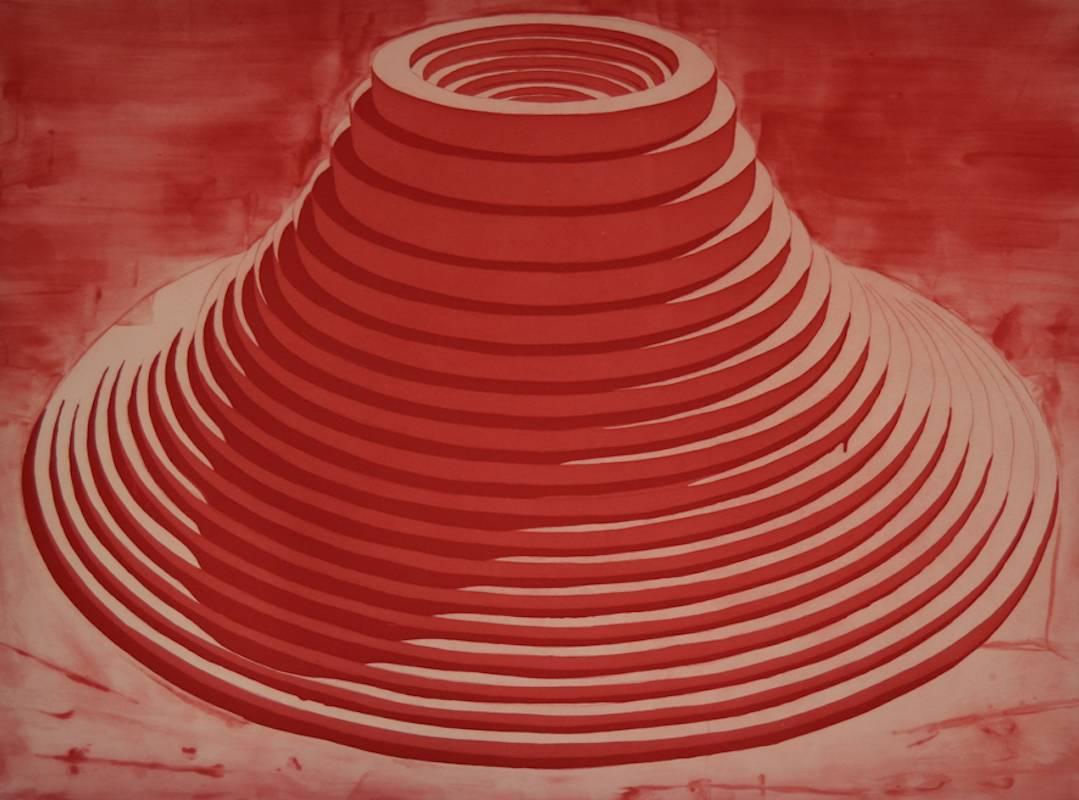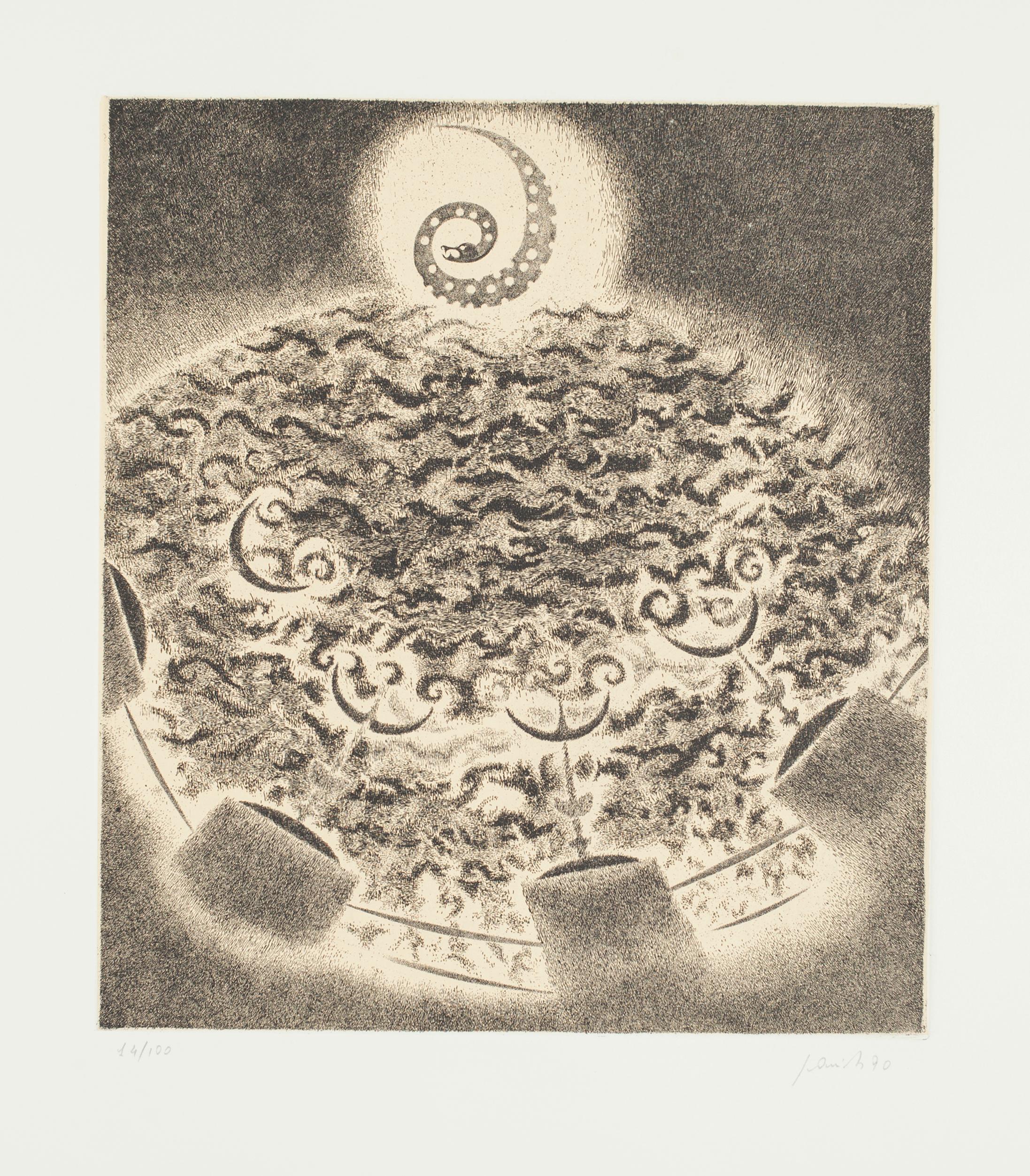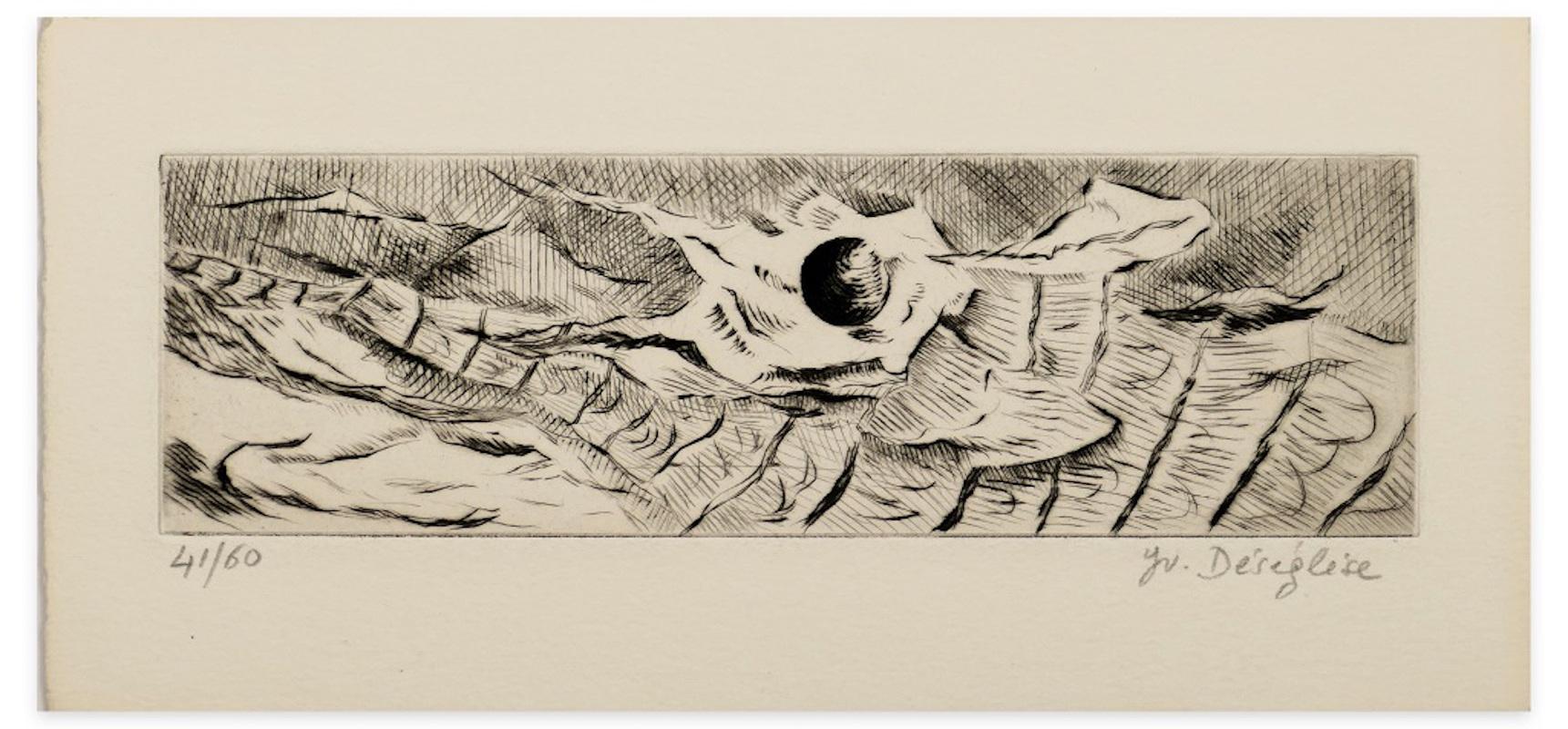Items Similar to Pensees Germinales
Want more images or videos?
Request additional images or videos from the seller
1 of 8
Mark TobeyPensees Germinales1973
1973
About the Item
Mark Tobey
"Pensees Germinales" 1973
Drypoint Engraving Printed in Brown and Blue by Willie Steinert, Karlsruhe, Germany, on Auvernge Paper Handmade by Richard de Bas
Signed Lower Right
From the Unnumbered Edition of 163
Image: 9 3/8 x 5 3/4 inches
Sheet: 21.5 x 15.5 inches
Framed: 32 x 26 inches
A painter of small abstract works with underlying religious themes as well as illustrator and muralist, Mark Tobey remains known primarily for his "white writing" paintings that give the impression of being expansive and much larger than they actually are. Tobey is sometimes categorized with the Abstract Expressionists, but in fact he was isolated spiritually and physically from its New York founders because of his immersion in Asian religion and major time spent in Europe and the Pacific Northwest.
Encountering the Bahai World faith in 1918 and later Zen Buddhism was pivotal to Mark Tobey's life and work in which he expressed themes of oneness and progression. As a result of his obvious commitment to spiritual aspects of painting, he has had a prestigious reputation as a modernist but is perhaps more appreciated in Europe and Asia than in America. Of modern American art, he said: "There have been 32 isms since the advent of cubism, . . . we have just been confused by the storm. . . we forget that there are today great men in the religious field with as much to offer. . .religion like science must be balanced to bring men to a state of equilibrium and that and that only will bring peace." (Herskovic 338)
Mark Tobey was born in Centerville, Wisconsin, and raised in the Midwest, lived in Indiana and Chicago where he briefly attended the Art Institute School. He worked as a commercial illustrator, and from 1911 to 1922, worked in New York City where he did fashion illustration and caricature for McCalls magazine and other publications. He also took private lessons from Kenneth Hayes Miller.
With a keen interest in philosophy and religion, especially beliefs of the Orient and Middle East, Mark Tobey's official affiliation with non-western religions began in 1918 when he converted to the Bahai faith and joined their World Church. Then between 1923 and 1931, he lived in several places including Seattle, Paris, New York City and Chicago. In Seattle, Tobey studied Chinese brush-work with Teng Kuei. From 1931 to 1938, he lived in England, where he was resident artist at the progressive school, Darlington Hall, near the town of Darlington. After that, until 1960, when he moved to Basel, Switzerland, Mark Tobey lived in Seattle where he was close to persons of Asian culture.
His painting subjects included portrait and genre scenes, but after 1935, he developed his signature technique of "white writing", described by scholar Matthew Baigell as a "tangle of thin, continuous linear strokes" linked to Oriental calligraphy and created from his desire not to be bound to realistic form. "For him, the white lines symbolized light as a unifying idea which flows through the compartmental units of life." He avoided focal points in his paintings and let the lines blur so that the overall canvas became a symbol "of the unity of forms and movements in the universe rather than an example of traditional organization hierarchies in which dominant elements brought lesser ones into subordination." His paintings reflect substance but not solidity, a sense of "cosmic wholeness, suggesting matter, space with nonspace and indivdual stroke with the totality of the pictorial field".
Sources include:
Matthew Baigell, Dictionary of American Art, pp. 354-355
Marika Herskovic, Editor, American Abstract Expressionists of the 1950s
- Creator:Mark Tobey (1890-1976, American)
- Creation Year:1973
- Dimensions:Height: 32 in (81.28 cm)Width: 26 in (66.04 cm)Depth: 1 in (2.54 cm)
- Medium:
- Movement & Style:
- Period:
- Condition:
- Gallery Location:Missouri, MO
- Reference Number:1stDibs: LU74735782522
About the Seller
5.0
Vetted Seller
These experienced sellers undergo a comprehensive evaluation by our team of in-house experts.
Established in 1970
1stDibs seller since 2017
141 sales on 1stDibs
Typical response time: 23 hours
- ShippingRetrieving quote...Ships From: Missouri, MO
- Return PolicyA return for this item may be initiated within 2 days of delivery.
More From This SellerView All
- Observador de PajarosBy Rufino TamayoLocated in Missouri, MO"Observador de Pajaros" 1950 By. Rufino Tamayo (Mexican, 1899-1991) Edition 83/210 Lower Right Signed Lower Left Unframed: 15.5" x 22.5" Framed: 21.75" x 28.25" Rufino Tamayo (August 26, 1899- June 24, 1991) A native of Oaxaca in Southern Mexico, Rufino Tamayo's father was a shoemaker, and his mother a seamstress. Some accounts state that he was descended from Zapotec Indians, but he was actually 'mestizo' - of mixed indigenous/European ancestry. (Santa Barbara Museum of Art). He began painting at age 11. Orphaned at the age of 12, Tamayo moved to Mexico City, where he was raised by his maternal aunt who owned a wholesale fruit business. In 1917, he entered the San Carlos Academy of Fine Arts, but left soon after to pursue independent study. Four years later, Tamayo was appointed the head designer of the department of ethnographic drawings at the National Museum of Archaeology in Mexico City. There he was surrounded by pre-Colombian objects, an aesthetic inspiration that would play a pivotal role in his life. In his own work, Tamayo integrated the forms and tones of pre-Columbian ceramics into his early still lives and portraits of Mexican men and women. In the early 1920s he also taught art classes in Mexico City's public schools. Despite his involvement in Mexican history, he did not subscribe to the idea of art as nationalistic propaganda. Modern Mexican art at that time was dominated by 'The Three Great Ones' : Diego Rivera, Jose Clemente Orozco, and David Alfaro Siqueros, but Tamayo began to be noted as someone 'new' and different' for his blending of the aesthetics of post Revolutionary Mexico with the vanguard artists of Europe and the United States. After the Mexican Revolution, he focused on creating his own identity in his work, expressing what he thought was the traditional Mexico, and refusing to follow the political trends of his contemporary artists. This caused some to see him as a 'traitor' to the political cause, and he felt it difficult to freely express himself in his art. As a result, he decided to leave Mexico in 1926 and move to New York, along with his friend, the composer Carlos Chavez. The first exhibition of Tamayo's work in the United States was held at the Weyhe Gallery, New York, in that same year. The show was successful, and Tamayo was praised for his 'authentic' status as a Mexican of 'indigenous heritage', and for his internationally appealing Modernist aesthetic. (Santa Barbara Museum of Art). Throughout the late thirties and early forties New York's Valentine Gallery gave him shows. For nine years, beginning in 1938, he taught at the Dalton School in New York. In 1929, some health problems led him to return to Mexico for treatment. While there he took a series of teaching jobs. During this period he became romantically involved with the artist Maria...Category
20th Century Abstract Abstract Prints
MaterialsLithograph
- FramedBy Sam FrancisLocated in Missouri, MOFramed Sam Francis (American, 1923-1994) Edition 58/100 in pencil Lower Left Signed in pencil Lower Right 17 x 22 inches 25.5 x 30.5 inches An Abstract Expressionist* painter known ...Category
1960s Abstract Abstract Prints
MaterialsColor, Lithograph
- Red and Green BubblesBy Victor VasarelyLocated in Missouri, MOVictor Vasarely "Red and Green Bubbles" c. 1970 Color Serigraph Signed and Numbered Ed. 125 Framed Size: 34 x 29.5 inches Image: approx 18 x 18 inchesCategory
1970s Abstract Geometric Abstract Prints
MaterialsLithograph
- St. Louis Symphony Orchestra (Poster) -- signed limited editionBy Robert MotherwellLocated in Missouri, MOOriginal color lithograph designed by Robert Motherwell for the 94th Season, Powell Symphony Hall, St. Louis Symphony Orchestra From the limited edition of 120 + A.P.s on Arches Cove...Category
1970s Abstract Expressionist Abstract Prints
MaterialsLithograph
- Sphere and CubeBy Victor VasarelyLocated in Missouri, MOVictor Vasarely "Sphere and Cube" c. 1970 Serigraph Signed and Numbered Ed. 250 Framed Size: 42 x 31 inches Image Size: 28 x 21 inchesCategory
1970s Abstract Geometric Abstract Prints
MaterialsLithograph
- Abstract in Purple and GreenBy Victor VasarelyLocated in Missouri, MOVictor Vasarely "Abstract" c. 1970 Serigraph Ed. 275 Signed and Numbered Image Size: 23.5 x 23.5 Framed: approx 34 x 34.5 inchesCategory
1970s Abstract Geometric Abstract Prints
MaterialsLithograph
You May Also Like
- "Target With Plaster Cast Black and White" Drypoint Etching and AquatintBy Jasper JohnsLocated in Mount Laurel, NJArtist: Jasper Johns Title: Target With Plaster Cast Black and White Medium: Drypoint, Etching, Aquatint Edition: AP IV/XVI Date: 1990 Dimensi...Category
1990s Abstract Abstract Prints
MaterialsDrypoint, Etching, Aquatint
- Mapa frente al espejo (Africa) / Map in front of the Mirror (Africa)By Alexandre ArrecheaLocated in Mexico City, MXAlexandre Arrechea´s work remains caught in an endless uphill climb towards a new representational framework. The pieces he produces serve as a warning of our own limits and how pret...Category
2010s Abstract Abstract Prints
MaterialsDrypoint, Aquatint
- Vulcano 1By Alexandre ArrecheaLocated in Mexico City, MXAlexandre Arrechea´s work remains caught in an endless uphill climb towards a new representational framework. The pieces he produces serve as a warning of our own limits and how pret...Category
2010s Abstract Abstract Prints
MaterialsDrypoint, Aquatint
- Spiral - Original Etching by Edo Janich - 1970sBy Edo JanichLocated in Roma, ITSpiral is an original, splendid etching and drypoint realized by Edo Janich in 1990. The state of preservation of the artwork is excellent. hand-signed n...Category
1970s Abstract Abstract Prints
MaterialsDrypoint, Etching
- Abstract Landscape - Etching and Drypoint - 1970sLocated in Roma, ITImage dimensions: 5.5 x 18 cm. Abstrahierte Landschaft is a black and white etching on paper realized the 1970's by an artist whose signature is not completely readable. Signed "Y...Category
1970s Abstract Abstract Prints
MaterialsDrypoint, Etching
- Large Italian Aquatint Etching Francesco Clemente Neo Expressionist Avant GardeBy Francesco ClementeLocated in Surfside, FLFrancesco Clemente (Italian b. 1952), 'This side up / Telemone #2, 1981 Medium: Intaglio hard ground etching, color aquatint, drypoint, and soft-ground etching with chine collé (ha...Category
1980s Abstract Expressionist Abstract Prints
MaterialsDrypoint, Etching, Aquatint, Intaglio
Recently Viewed
View AllMore Ways To Browse
Light And Space Modernist Art
Church Engraving
Vintage Fashion Illustration Prints
Engraving Chicago
1950s American Magazine Illustrations
Large Blue And White Oriental
1970 Fashion Illustration
Vintage Calligraphy Brushes
Mark Lesser
German Expressionist Portrait Prints
3 X 5 Abstract Expressionist
Orient Express Vintage
Retro Calligraphy Brush
1960 Storm Painting
Storm Painting Western
Vintage Dictionary Paper
Vintage Chinese Calligraphy Brush
Retro Chinese Calligraphy Brush





